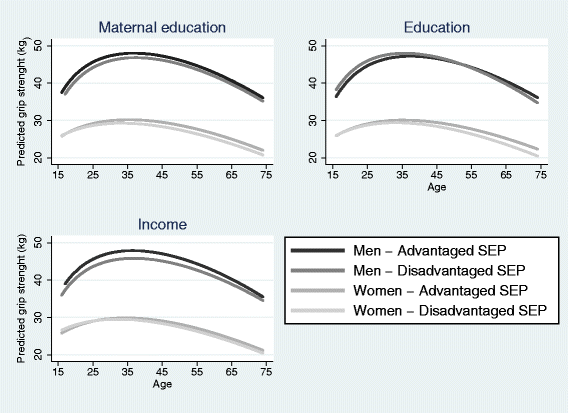Social patterning in grip strength and in its association with age; a cross sectional analysis using the UK Household Longitudinal Study (UKHLS)
- PMID: 29562880
- PMCID: PMC5863489
- DOI: 10.1186/s12889-018-5316-x
Social patterning in grip strength and in its association with age; a cross sectional analysis using the UK Household Longitudinal Study (UKHLS)
Abstract
Background: Grip strength in early adulthood and midlife is an important predictor of disability, morbidity and mortality in later life. Understanding social patterning in grip strength at different life stages could improve insight into inequalities in age-related decline and when in the life course interventions could prevent the emergence of inequalities.
Methods: Using United Kingdom Household Longitudinal Study (UKHLS) data on 19,292 people aged 16 to 99, fractional polynomial models were fitted to identify which function of age best described its association with grip strength. Linear regressions were used to establish whether socio-economic position (SEP), as measured by maternal education, highest educational qualification and income, was associated with grip strength. To test whether the association between age and grip strength was modified by SEP, interactions between SEP and the age terms were added. Differentiation was used to identify the age at which grip strength was highest for men and women and predicted levels of grip strength at peak were compared.
Results: SEP is significantly associated with grip strength on all SEP measures, except education for men. Grip strength is highest at a younger age, and less strong for all measures of disadvantage for women and most measures for men. Interaction terms were not statistically significant indicating that the association between age and grip strength was not modified by SEP. Grip strength peak was 29.3 kg at age 33 for women with disadvantaged childhood SEP compared with 30.2 kg at age 35 for women with advantaged childhood SEP.
Conclusion: The SEP differences in age and level of peak grip strength could be indicative of decline in muscle strength beginning earlier and from a lower base for disadvantaged groups. This could impact on the capacity for healthy ageing for those with disadvantaged SEP.
Keywords: Age; Cross-sectional; Grip strength; Life-course; Socio-economic position; UKHLS.
Conflict of interest statement
Authors’ information
Not applicable
Ethics approval and consent to participate
The NHA protocol for the collection of biosocial data by trained nurses in Waves 2 and 3 of the main survey was approved by the National Research Ethics Service (Understanding Society - UK Household Longitudinal Study: A Biosocial Component, Oxfordshire A REC, Reference: 10/H0604/2).
Ethical approval for the mainstage survey is detailed in the wave 1–6 user guide, available at
Consent for publication
Not applicable
Competing interests
The authors declare that they have no competing interests.
Publisher’s Note
Springer Nature remains neutral with regard to jurisdictional claims in published maps and institutional affiliations.
Figures

Similar articles
-
Associations between childhood and adulthood socioeconomic position and grip strength at age 46 years: findings from the 1970 British Cohort Study.BMC Public Health. 2022 Jul 27;22(1):1427. doi: 10.1186/s12889-022-13804-7. BMC Public Health. 2022. PMID: 35883072 Free PMC article.
-
The moderating effect of childhood disadvantage on the associations between smoking and occupational exposure and lung function; a cross sectional analysis of the UK Household Longitudinal Study (UKHLS).BMC Public Health. 2019 Jun 4;19(1):690. doi: 10.1186/s12889-019-7039-z. BMC Public Health. 2019. PMID: 31164109 Free PMC article.
-
Does socio-economic status predict grip strength in older Europeans? Results from the SHARE study in non-institutionalised men and women aged 50+.J Epidemiol Community Health. 2010 Sep;64(9):829-37. doi: 10.1136/jech.2009.088476. Epub 2009 Nov 1. J Epidemiol Community Health. 2010. PMID: 19884112
-
Continuity and change in the social stratification of aging and health over the life course: evidence from a nationally representative longitudinal study from 1986 to 2001/2002 (Americans' Changing Lives Study).J Gerontol B Psychol Sci Soc Sci. 2005 Oct;60 Spec No 2:15-26. doi: 10.1093/geronb/60.special_issue_2.s15. J Gerontol B Psychol Sci Soc Sci. 2005. PMID: 16251586 Review.
-
Frailty and socioeconomic position: A systematic review of observational studies.Ageing Res Rev. 2024 Sep;100:102420. doi: 10.1016/j.arr.2024.102420. Epub 2024 Jul 16. Ageing Res Rev. 2024. PMID: 39025269
Cited by
-
Factors Affecting Handgrip Strength in Menopausal Women at High Risk of Sarcopenia: A National Population-Based Study.Healthcare (Basel). 2024 Dec 23;12(24):2590. doi: 10.3390/healthcare12242590. Healthcare (Basel). 2024. PMID: 39766017 Free PMC article.
-
The Neighborhood Environment and Handgrip Strength: Longitudinal Findings From the Health and Retirement Study.J Gerontol A Biol Sci Med Sci. 2024 Nov 1;79(11):glae242. doi: 10.1093/gerona/glae242. J Gerontol A Biol Sci Med Sci. 2024. PMID: 39360832 Free PMC article.
-
Associations between childhood and adulthood socioeconomic position and grip strength at age 46 years: findings from the 1970 British Cohort Study.BMC Public Health. 2022 Jul 27;22(1):1427. doi: 10.1186/s12889-022-13804-7. BMC Public Health. 2022. PMID: 35883072 Free PMC article.
-
Physical capability in a rural birth cohort at the age of 52: association with early environmental, nutritional, and developmental factors.BMC Geriatr. 2022 Feb 10;22(1):113. doi: 10.1186/s12877-022-02801-5. BMC Geriatr. 2022. PMID: 35144547 Free PMC article.
-
Associations between objectively assessed physical fitness levels and sleep quality in community-dwelling elderly people in South China.Sleep Breath. 2019 Jun;23(2):679-685. doi: 10.1007/s11325-018-1749-9. Epub 2018 Nov 6. Sleep Breath. 2019. PMID: 30402777
References
-
- Silventoinen K, Magnusson PK, Tynelius P, Batty GD, Rasmussen F. Association of body size and muscle strength with incidence of coronary heart disease and cerebrovascular diseases: a population-based cohort study of one million Swedish men. Int J Epidemiol. 2009;38(1):110–118. doi: 10.1093/ije/dyn231. - DOI - PubMed
Publication types
MeSH terms
LinkOut - more resources
Full Text Sources
Other Literature Sources
Medical

